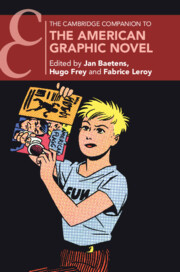Book contents
- The Cambridge Companion to the American Graphic Novel
- The Cambridge Companion to the American Graphic Novel
- Copyright page
- Contents
- Figures
- Contributors
- Editors’ Acknowledgments
- Introduction
- Part I History and Genre
- Part II Graphic Novels and the Quest for an American Diversity
- 10 Expressions of Jewishness alongside Grief in American Graphic Novels
- 11 Black Looking and Looking Black
- 12 African American New History-Writing in Graphic Narratives
- 13 Coming to America, “Land of the Free”
- 14 Spatiotemporal Projections
- 15 Queer Graphic Novels
- 16 American Women’s Lives in Graphic Novels
- Index
- Cambridge Companions To …
- References
13 - Coming to America, “Land of the Free”
Asian American Representations in Graphic Narrative
from Part II - Graphic Novels and the Quest for an American Diversity
Published online by Cambridge University Press: 10 January 2024
- The Cambridge Companion to the American Graphic Novel
- The Cambridge Companion to the American Graphic Novel
- Copyright page
- Contents
- Figures
- Contributors
- Editors’ Acknowledgments
- Introduction
- Part I History and Genre
- Part II Graphic Novels and the Quest for an American Diversity
- 10 Expressions of Jewishness alongside Grief in American Graphic Novels
- 11 Black Looking and Looking Black
- 12 African American New History-Writing in Graphic Narratives
- 13 Coming to America, “Land of the Free”
- 14 Spatiotemporal Projections
- 15 Queer Graphic Novels
- 16 American Women’s Lives in Graphic Novels
- Index
- Cambridge Companions To …
- References
Summary
Stories of Asian immigration to North America have developed a series of recognizable tropes, from exile for economic or political reasons to arrival and the subsequent struggles of discrimination, assimilation, and self-identity. This chapter identifies the preferred themes of graphic novel publishers, who continue to seek and legitimize a familiar model of Asian American narrative: that of origin and identity stories, often autobiographical in nature, in which authors grapple with assimilation difficulties and express identity challenges, notably when self-acceptance and community acceptance are not always aligned (e.g., in celebrated works by Adrian Tomine and Gene Luen Yang). The chapter also considers other types of narratives: family stories in which a mixed heritage challenges social norms (Lynda Barry), graphic memoirs from second-generation Asian Americans on their immigrant mothers and their cultural transition, and refugee narratives from authors of the Vietnamese diaspora who reflect on the Vietnam War and the perilous immigration of “boat people.”
Keywords
- Type
- Chapter
- Information
- The Cambridge Companion to the American Graphic Novel , pp. 226 - 241Publisher: Cambridge University PressPrint publication year: 2023

